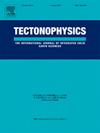坦桑尼亚Rukwa裂谷盆地地震地层格架、沉积中心扩散与氦储层
IF 2.6
3区 地球科学
Q2 GEOCHEMISTRY & GEOPHYSICS
引用次数: 0
摘要
坦桑尼亚西南部的Rukwa裂谷盆地为氦气的赋存和聚集提供了有利的地质条件。然而,这些与氦有关的有利条件的演变和动态仍然很复杂。本研究结合实验室岩心样品、二维地震反射数据、数字高程模型(DEM)和井资料,绘制了沉积分布和潜在氦储层。等时线和时间-厚度图揭示了晚古生代至晚新生代各裂谷期沉积中心位置和地层扩散在空间和时间上的变化。结果表明,在多期裂陷历史中,与下盘隆升相关的地形高点调节了RRB的沉积、差异侵蚀模式、排水系统和沉积物路线,而沉积中心的分布则由地形高点决定。萨萨剪切带以南的沉积中心可能在卡鲁裂陷期初期是孤立的,在白垩纪时期是连片的,在晚中新世至更新世的裂陷后期连接成一个主沉积中心。岩石物理分析显示孔隙度和渗透率较高,分别为~ 26 ~ 30%和~ 272.7 ~ 660.6 mD。这些岩石物性参数对于主要由卡鲁和红砂岩层序组成的潜在氦储层来说足够高。本文章由计算机程序翻译,如有差异,请以英文原文为准。
Seismic stratigraphic framework, dispersal of depocenters, and helium reservoirs in the Rukwa Rift Basin, Tanzania
The Rukwa Rift Basin (RRB) in the southwestern Tanzania presents favourable geological conditions for the occurrence and accumulation of helium gas. However, the evolution and dynamics of these favourable conditions in relation to helium remain complex. In this study, laboratory- cored samples, 2D seismic reflection data, Digital Elevation Model (DEM) and well data are integrated to map the distribution of sediment accumulation and potential helium reservoirs. The isochron and time-thickness maps unveil that the RRB experienced a shift in depocenter location and progressive strata dispersal in space and time during each of the rifting phases from the late Paleozoic to the late Cenozoic. The results reveal a change in morphology while distribution of depocenters is defined by topographic highs related to footwall uplift during a multiphase rifting history that modulated the deposition, differential erosional patterns, drainage system and sediment routing in the RRB. The depocenters to the south of the Saza shear zone might have been isolated initially during Karoo rifting, contiguous during Cretaceous and linked into a single main depocenter during the latter stages of rifting between late Miocene and Pleistocene. Petrophysical analysis reveal high porosity and permeability ranges, that is ∼26–30 % and ∼ 272.7–660.6 mD respectively. These petrophysical parameters are high enough for potential helium reservoirs comprising sandstone sequences mainly in the Karoo and Red Sandstone formations.
求助全文
通过发布文献求助,成功后即可免费获取论文全文。
去求助
来源期刊

Tectonophysics
地学-地球化学与地球物理
CiteScore
4.90
自引率
6.90%
发文量
300
审稿时长
6 months
期刊介绍:
The prime focus of Tectonophysics will be high-impact original research and reviews in the fields of kinematics, structure, composition, and dynamics of the solid arth at all scales. Tectonophysics particularly encourages submission of papers based on the integration of a multitude of geophysical, geological, geochemical, geodynamic, and geotectonic methods
 求助内容:
求助内容: 应助结果提醒方式:
应助结果提醒方式:


